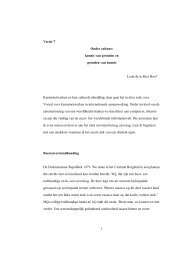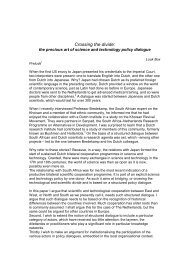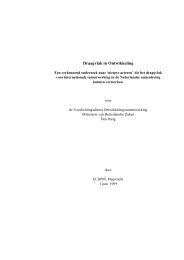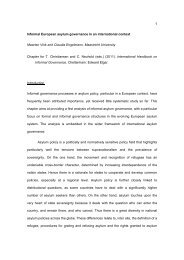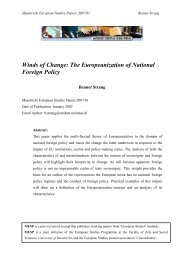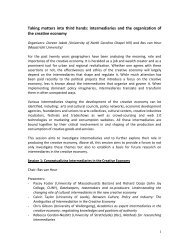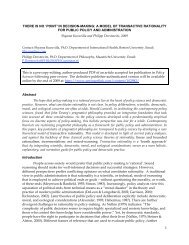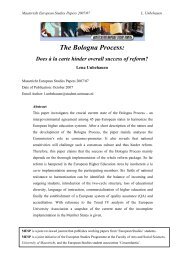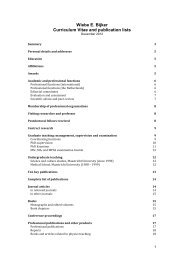the case of the synthetic dye industry, 1857–1914 - Maastricht ...
the case of the synthetic dye industry, 1857–1914 - Maastricht ...
the case of the synthetic dye industry, 1857–1914 - Maastricht ...
You also want an ePaper? Increase the reach of your titles
YUMPU automatically turns print PDFs into web optimized ePapers that Google loves.
198 J.P. Murmann and E. Homburg<br />
times). 26 British, German and Swiss producers had always supplied <strong>the</strong> bulk<br />
<strong>of</strong> <strong>dye</strong>s to American <strong>dye</strong>rs and printers. Especially after <strong>the</strong> textile lobby was<br />
able to persuade <strong>the</strong> U.S. Congress in 1883 to lower <strong>the</strong> tariffs on syn<strong>the</strong>tic <strong>dye</strong>s<br />
by removing <strong>the</strong> 50 cents per pound specific duty (in addition to an ad valorem<br />
duty), half <strong>of</strong> <strong>the</strong> existing U.S. firms failed. This led to an even greater dependence<br />
on foreign producers. Just as in <strong>the</strong> <strong>case</strong> <strong>of</strong> Britain, <strong>the</strong> powerful textile<br />
<strong>industry</strong> <strong>of</strong> <strong>the</strong> United States was able to prevent, with one exception in 1897,<br />
<strong>the</strong> enactment <strong>of</strong> higher tariffs (Haynes, 1954, p. 311). 27 What, <strong>the</strong>n, caused an<br />
increase in <strong>the</strong> number <strong>of</strong> firms just before <strong>the</strong> First World War?<br />
It is well known in <strong>the</strong> historiography <strong>of</strong> <strong>the</strong> American <strong>dye</strong> <strong>industry</strong> that before<br />
1914 some German and Swiss firms opened subsidiaries in <strong>the</strong> U.S. where <strong>the</strong>y<br />
produced small quantities <strong>of</strong> <strong>dye</strong>s while shipping most <strong>of</strong> <strong>the</strong> <strong>dye</strong>s to <strong>the</strong> U.S.<br />
from Europe. To rule out <strong>the</strong> possibility that <strong>the</strong> increase in <strong>the</strong> number <strong>of</strong> firms<br />
was solely due to newly-established German and Swiss subsidiaries in <strong>the</strong> U.S.,<br />
we analyzed <strong>the</strong> <strong>industry</strong> structures in <strong>the</strong> 5 countries omitting from <strong>the</strong> sample<br />
those firms that were owned by ano<strong>the</strong>r <strong>dye</strong> firm (see Fig. 5 for <strong>the</strong> results <strong>of</strong> this<br />
analysis). In <strong>the</strong> <strong>case</strong> <strong>of</strong> <strong>the</strong> U.S. this means, for example, that all subsidiaries<br />
<strong>of</strong> foreign firms would not count as part <strong>of</strong> <strong>the</strong> U.S. <strong>dye</strong> <strong>industry</strong>. Based on this<br />
definition <strong>of</strong> a domestic <strong>industry</strong>, no firm operated in <strong>the</strong> American <strong>dye</strong> <strong>industry</strong><br />
in <strong>the</strong> years from 1869 to 1875, and after 1875 <strong>the</strong>re was always at least one<br />
British, German and Swiss firm that ran a subsidiary in <strong>the</strong> U.S. But even under<br />
this restricted definition <strong>of</strong> <strong>the</strong> U.S. <strong>dye</strong> <strong>industry</strong>, a sharp increase in <strong>the</strong> number<br />
<strong>of</strong> firms shows up starting in 1908. American-owned firms are clearly behind<br />
this entry wave. The number <strong>of</strong> firms jumps from 5 in 1906 to 12 in 1909.<br />
The most likely factor responsible for <strong>the</strong> increase in <strong>the</strong> number <strong>of</strong> U.S.<br />
firms is that <strong>the</strong> technology for some organic intermediates had gradually diffused<br />
to <strong>the</strong> U.S. Although most <strong>dye</strong> intermediates were still imported at this<br />
time from Germany, <strong>the</strong> availability <strong>of</strong> some <strong>dye</strong> intermediates in <strong>the</strong> U.S. allowed<br />
entrepreneurs to enter <strong>the</strong> <strong>industry</strong> in niche markets where <strong>the</strong>y would not<br />
be as easily attacked by <strong>the</strong> large German and Swiss <strong>dye</strong> firms. The most concerted<br />
effort to break <strong>the</strong> German hold upon key coal-tar intermediates was <strong>the</strong><br />
Benzol Products company, which was organized in 1910 by <strong>the</strong> suppliers <strong>of</strong> key<br />
raw-materials – General Chemical, acids; Semet-Solvay, benzol and alkalis; and<br />
Barrett, which provided <strong>the</strong> plant. When <strong>the</strong> new company began to sell its products,<br />
German producers started a price-war, absorbing a recently enacted 10%<br />
tariff on aniline oil and lowering prices to undercut <strong>the</strong> new entrant (Welsh, 1944,<br />
pp. 65–66; Haynes, 1954, pp. 316–317). The Benzol company in <strong>the</strong> beginning<br />
sold aniline for $0.115 per pound and later could only charge $0.02 per pound.<br />
While <strong>the</strong> dramatic reduction in price was bad for <strong>the</strong> company itself – it rarely<br />
made a pr<strong>of</strong>it before <strong>the</strong> First World War – it is likely that local entrepreneurs<br />
took advantage <strong>of</strong> much lower intermediate prices and entered <strong>the</strong> syn<strong>the</strong>tic <strong>dye</strong><br />
<strong>industry</strong>.<br />
26 The British textile market was still twice as large as that <strong>of</strong> <strong>the</strong> U.S.<br />
27 Hesse (1915) provides a very detailed account <strong>of</strong> <strong>the</strong> battle for <strong>dye</strong> tariffs from <strong>the</strong> 1860s until<br />
1914. See also Steen (1995) for data on how <strong>the</strong> tariff levels changed from 1864 to 1914.



